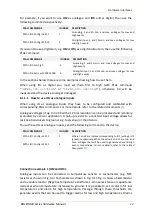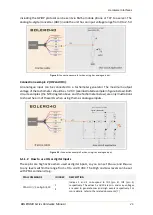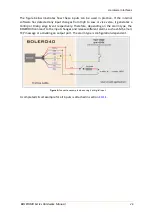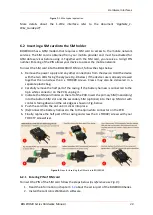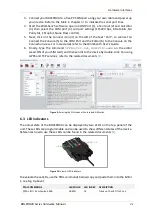
Appendix
BOLERO40 Series Hardware Manual
36
CAUTION!
Turn the car ignition off before making any connection. Use a common ground point for all device
grounds. Do not connect power from different voltage sources to the BOLERO40. The outputs must be
connected to the same voltage level as applied to the DC +IN. To prevent any damage to the BOLERO40
Series, the input voltage should never exceed the maximum voltage limit.
9.2
What should be considered when using BOLERO40 Series
BOLERO40 is controlled by means of the PFAL commands. which are developed by
Lantronix. These PFAL commands can only be executed when the device is on and the
firmware inside the device is running. In order to create application with the BOLERO40 and
to obtain maximum benefit from the BOLERO40 operating firmware, you have to setup your
configuration and store it in the device. All PFAL commands can be sent to the BOLERO40
with the help of the Workbench software, which is free of charge and can be downloaded
from the Lantronix website
(
http://www.lantronix.com
)
. All PFAL commands
supported by the BOLERO40 and other AVL devices are listed in the related documents
9.3
NMEA data message
BOLERO40 deliver data in the NMEA-0183 format and Lantronix own format. The table
below lists the NMEA and Lantronix supported protocols and gives also a brief description
for each of them. For further description about these protocols, refer to the related
documents
[1].
These protocols can be sent via SMS, TCP, data call, serial port, e-mail or stored inside the
device using the corresponding PFAL-Commands. For example, the PFAL-Command
"$PFAL,GSM.Send.TCP...
" allows sending the protocols via TCP to a remote server
including the current device location, GPS state, UTC time, date, speed and course over
ground. The received protocols by the server can then be used for graphically
representation of the device location. Installing such a device in a vehicle, lets you know
where your vehicle is, what is happening with your vehicle, has your vehicle been moved
without authorization from a park area, updating vehicle movements in real time and more.
NMEA
Description
GPGGA
It contains GPS time, position and fix type data.
GPGLL
It contains GPS latitude, longitude, UTC time of position fix and status.
GPGSA
It contains satellites used in the GPS position solution and DOP values.
GPVTG
It contains the number of GPS satellites in view satellite ID numbers, elevation, azimuth and
SNR values.
GPGSV
It contains the number of GPS satellites in view satellite ID numbers, elevation, azimuth and
SNR values.
GPRMC
It contains GPS time, date, position, course and speed data.
GLGSA
It contains the GNSS DOP and Active Satellites (if GLONASS activated)
GLGSV
It contains the GNSS satellites in view (if GLONASS activated)
Table 9
: NMEA Output Messages
NMEA
Description



